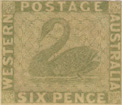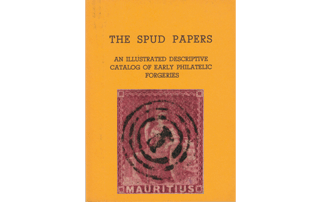Spud Papers – Western Australia
There are, apparently, two dies for these stamps, one for the penny, and one for the other values. The background of the four labels is formed of zig-zag white lines in the penny, but is solid in the higher values.
 1859. One Penny, black. Imperforate.
1859. One Penny, black. Imperforate.
Genuine
Engraved in taille-douce on greyish-white paper. The W of name is cut off square at the bottom. There is a mark just before P of POSTAGE which looks like a w placed sideways, with the commencement of another w. After E of POSTAGE there is a mark like the Masonic square-and-compass emblem, also placed sideways. The first and last letters of AUSTRALIA are both very close to the outer border. Background of engine-turning.
Forged
Lithographed on very white paper, imperf. This stamp is printed in very deep black, not at all like the grey-black of the originals. The w of name is sharply pointed at the bottom, POSTAGE on solid label, without marks. First and last letters of AUSTRALIA are at some little distance from the border, but the first is nearer than the last. Background of dots and scratches.

 1860. Two Pence, Vermillion, Six Pence, Green. Imperforate.
1860. Two Pence, Vermillion, Six Pence, Green. Imperforate.
Genuine
Engraved in taille-douce. Solid backgrounds to labels (this is copied by the forgeries), w square at bottom as before. N of WESTERN almost touches the border. All the lettering of equal thickness. Central background composed of engine-turned lines.
Forged
Lithographed, no watermark, imperf.
W pointed at bottom, N of WESTERN at some little distance from border. Lettering of POSTAGE thicker than the rest. Central background of dots and scratches.

 1862-64. Two Pence, Blue, Six Pence, Violet-Brown; Perforated Various.
1862-64. Two Pence, Blue, Six Pence, Violet-Brown; Perforated Various.
Genuine
Same matrix as above. Tests, ditto.
Forged
Ditto, ditto. Not perforated.
 One Penny, Brownish Red; Perforated Various.
One Penny, Brownish Red; Perforated Various.
Genuine
Same type as One Penny, black. Same tests.
Forged
Same type as forgery of 1d., black. Same tests; not perforated.
 1865. Two Pence, Orange. Perforated 12 1/2.
1865. Two Pence, Orange. Perforated 12 1/2.
Genuine
Same tests as before.
Forged
Ditto. No watermark; not perforated.
The forgeries are all postmarked with four concentric circles. Some of them would pass muster very well amongst school boys, et hoc genus omne; I think the six pence, green, is most likely to deceive. The easiest instant test for the forgeries is, that they all have the w sharply pointed at the bottom ; whereas, in the genuine, the two bottom points of the w are cut off quite square. It seems very absurd that the forgers should persist in attempting to imitate well-engraved designs. If I were a forger, I should certainly only try my hand at counterfeiting lithographed originals. I remember a forgery of one lithographed original which I had the pleasure of dissecting some time ago (it was a green Hanover, I think), and the forgers had actually produced a copy which was better executed than the original; whereas, lithographed copies of taille-douce originals must, of necessity, be very poor imitations.
From “The Spud Papers” by Atless, Pemberton & Earée, 1871-1881.












Leave a Reply
Want to join the discussion?Feel free to contribute!